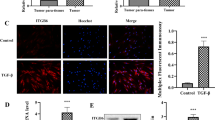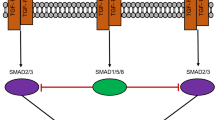Abstract
Background
To investigate the behavior of activated pancreatic stellate cells (PSCs), which express alpha-smooth muscle actin (α-SMA), and pancreatic cancer cells in vivo, we examined the expression of α-SMA-positive myofibroblast-like cells in pancreatic cancer tissue after treatment with gemcitabine (GEM) using a Lewis orthotopic rat pancreatic cancer model.
Methods
The effect of GEM on DSL-6A/C1 cell proliferation was determined by cell counting method. The orthotopic pancreatic cancer animals were prepared with DSL-6A/C cells, and treated with GEM (100 mg/kg/weekly, for 3 weeks). At the end of treatment, α-SMA expression, fibrosis, transforming growth factor (TGF)-β1 and vascular endothelial growth factor (VEGF) were evaluated by histopathological and Western blot analyses.
Results
DSL-6A/C1 cell proliferation was significantly reduced by co-culturing with GEM in vitro. Survival time of pancreatic cancer animals (59.6 ± 13.4 days) was significantly improved by treatment with GEM (89.6 ± 21.8 days; p = 0.0005). Alpha-SMA expression in pancreatic cancer tissue was significantly reduced after treatment with GEM (p = 0.03), however, there was no significant difference in Sirius-red expression. Expression of VEGF was significantly reduced by GEM treatment, but the expression of TGF-β1 was not inhibited.
Conclusion
GEM may suppress not only the tumor cell proliferation but also suppress PSCs activation through VEGF reduction.








Similar content being viewed by others
References
Apte MV, Haber PS, Applegate TL, Norton ID, McCaoughan GW, Korsten MA, et al. Periacinar stellate shaped cells in rat pancreas: identification, isolation, and culture. Gut. 1998;43:128–33.
Apte MV, Haber PS, Darby SJ, Rodgers SC, McCoughan GW, Korsten MA, et al. Pancreatic stellate cells are activated by proinflammatory cytokines: implications for pancreatic fibrogenesis. Gut. 1999;44:534–41.
Bachem MG, Schneider E, Gross H, Weidenbach H, Schmid RM, Menke A, et al. Identification, culture, and characterization of pancreatic stellate cells in rats and humans. Gastroenterology. 1998;115:421–32.
Haber PS, Keogh GW, Apte MV, Moran CS, Stewaart NL, Crawford DH, et al. Activation of pancreatic stellate cells in human and experimental pancreatic fibrosis. Am J Pathol. 1999;155:1087–95.
Jaster R. Molecular regulation of pancreatic stellate cell function. Mol Cancer. 2004;3:26–33.
Omary MB, Lugea A, Lowe AW, Pandol SJ. The pancreatic stellate cell: a star on the rise in pancreatic diseases. J Clin Invest. 2007;117:50–9.
Bachem MG, Schunemann M, Ramadani M, Siech M, Beger H, Buck A, et al. Pancreatic carcinoma cells induce fibrosis by stimulating proliferation and matrix synthesis of stellate cells. Gastroenterology. 2005;128:907–21.
Fujita H, Ohuchida K, Mizumoto K, Egami T, Miyoshi K, Moriyama T, et al. Tumor–stromal interactions with direct cell contacts enhance proliferation of human pancreatic carcinoma cells. Cancer Sci. 2009;100:2309–17.
Fujita H, Ohuchida K, Mizumoto K, Nakata K, Yu J, Kayashima T, et al. Alpha-smooth muscle actin expressing stroma promotes an aggressive tumor biology in pancreatic ductal adenocarcinoma. Pancreas. 2010;39:1254–62.
Pettengill OS, Faris RA, Bell RHJ, Kuhlmann ET, Longnecker DS. Derivation of duct-like cell lines from a transplantable acinar cell carcinoma of the rat pancreas. Am J Pathol. 1993;143:292–303.
Hotz HG, Reber HA, Hotz B, Foitzik T, Buhr HJ, Cortina G, et al. An improved clinical model of orthotopic pancreatic cancer in immunocompetent Lewis rats. Pancreas 2001;22:113–121.
Puchtler H, Waldrop FS, Valentine LS. Polarization microscopic studies of connective tissue stained with picro-sirius red FBA. Beitr Path. 1973;150:174–87.
Zeng WJ, Liu GY, Xu J, Zhou XD, Zhang YE, Zhang N. Pathological characteristics, PCNA labeling index and DNA index in prognostic evaluation of patients with moderately differentiated hepatocellular carcinoma. World J Gastroenterol. 2002;8:1040–4.
Apte MV, Park S, Phillips PA, Santucci N, Goldstein D, Kumar RK, et al. Desmoplastic reaction in pancreatic cancer: role of pancreatic stellate cells. Pancreas. 2004;29:179–87.
Hotz B, Buhr HJ, Hotz HG. Intravital microscopic characterization of suramin effects in an orthotopic immunocompetent rat model of pancreatic cancer. J Gastrointest Surg. 2008;12:900–6.
Erkan M, Kleeff J, Gorbachevski A, Reiser C, Mitkus T, Esposito I, et al. Periostin creates a tumor-supportive microenvironment in the pancreas by sustaining fibrogenic stellate cell activity. Gastroenterology. 2007;132:1447–64.
Seo Y, Baba H, Fukuda T, Takashima M, Sugimachi K. High expression of vascular endothelial growth factor is associated with liver metastasis and a poor prognosis for patients with ductal pancreatic adenocarcinoma. Cancer. 2000;88:2239–45.
Ikeda N, Adachi M, Taki T, Huang C, Hashida H, Takabayashi M, et al. Prognostic significance of angiogenesis in human pancreatic cancer. Br J Cancer. 1999;79:1553–63.
Knoll MR, Rudnitzki D, Sturm J, Manegold BC, Post S, Jaeger TM. Correlation of postoperative survival and angiogenic growth factors in pancreatic carcinoma. Hepatogastroenterology. 2001;48:1162–5.
Masamune A, Kikuta K, Watanabe T, Satoh K, Hirota M, Shimosegawa T. Hypoxia stimulates pancreatic stellate cells to induce fibrosis and angiogenesis in pancreatic cancer. Am J Physiol Gastrointest Liver Physiol. 2008;295:G709–17.
Fukumura D, Xavier R, Sugiura T, Chen Y, Park EC, Lu N, et al. Tumor induction of VEGF promoter activity in stromal cells. Cell. 1998;94:715–25.
Erkan M, Reiser-Erkan C, Michalski CW, Deucker S, Sauliunatite D, Streit S, et al. Cancer–stellate cell interactions perpetuate the hypoxia-fibrosis cycle in pancreatic ductal adenocarcinoma. Neoplasia. 2009;11:497–508.
Raimondi S, Lowenfels AB, Morselli-Labate AM, Maisonneuve P, Pezzilli R. Pancreatic cancer in chronic pancreatitis; aetiology, incidence, and early detection. Best Pract Res Clin Gastroenterol. 2010;24:349–58.
Conflict of interest
None.
Author information
Authors and Affiliations
Corresponding author
About this article
Cite this article
Yamao, J., Toyokawa, H., Kim, S. et al. Activation of alpha-smooth muscle actin-positive myofibroblast-like cells after chemotherapy with gemcitabine in a rat orthotopic pancreatic cancer model. J Hepatobiliary Pancreat Sci 20, 206–213 (2013). https://doi.org/10.1007/s00534-012-0576-9
Published:
Issue Date:
DOI: https://doi.org/10.1007/s00534-012-0576-9




